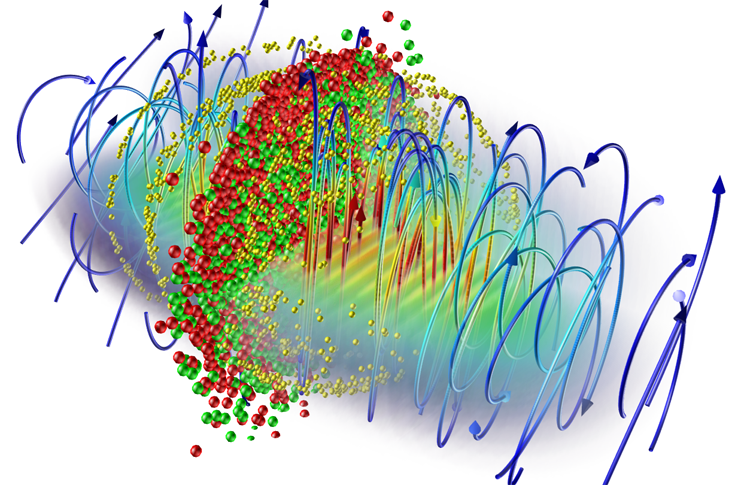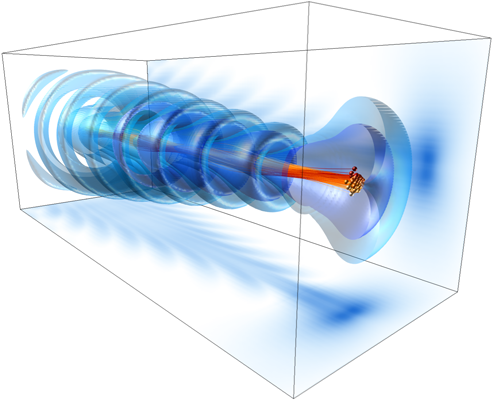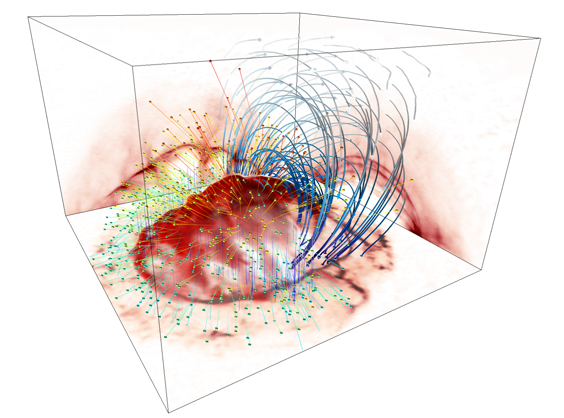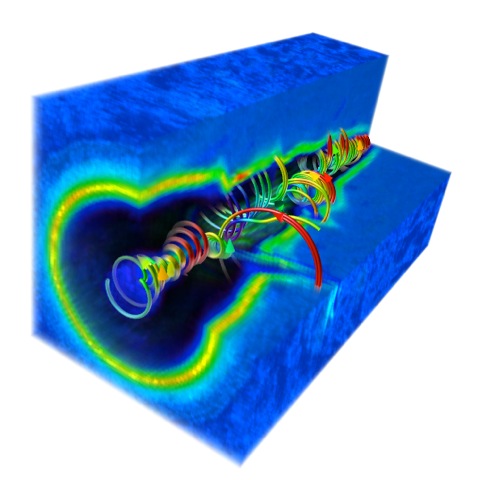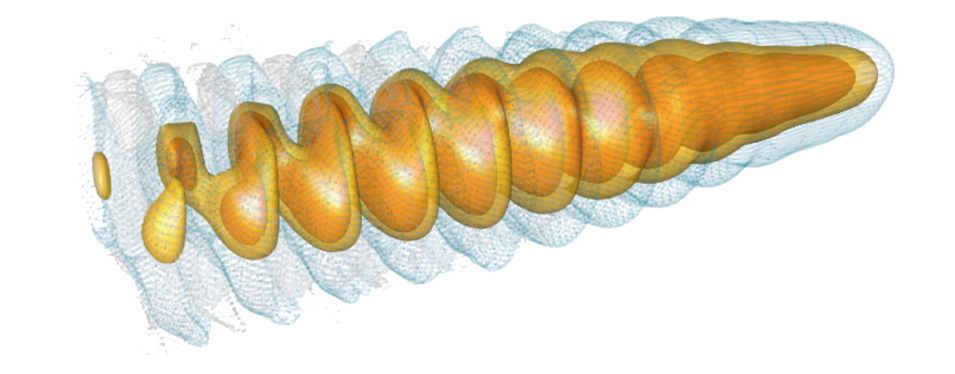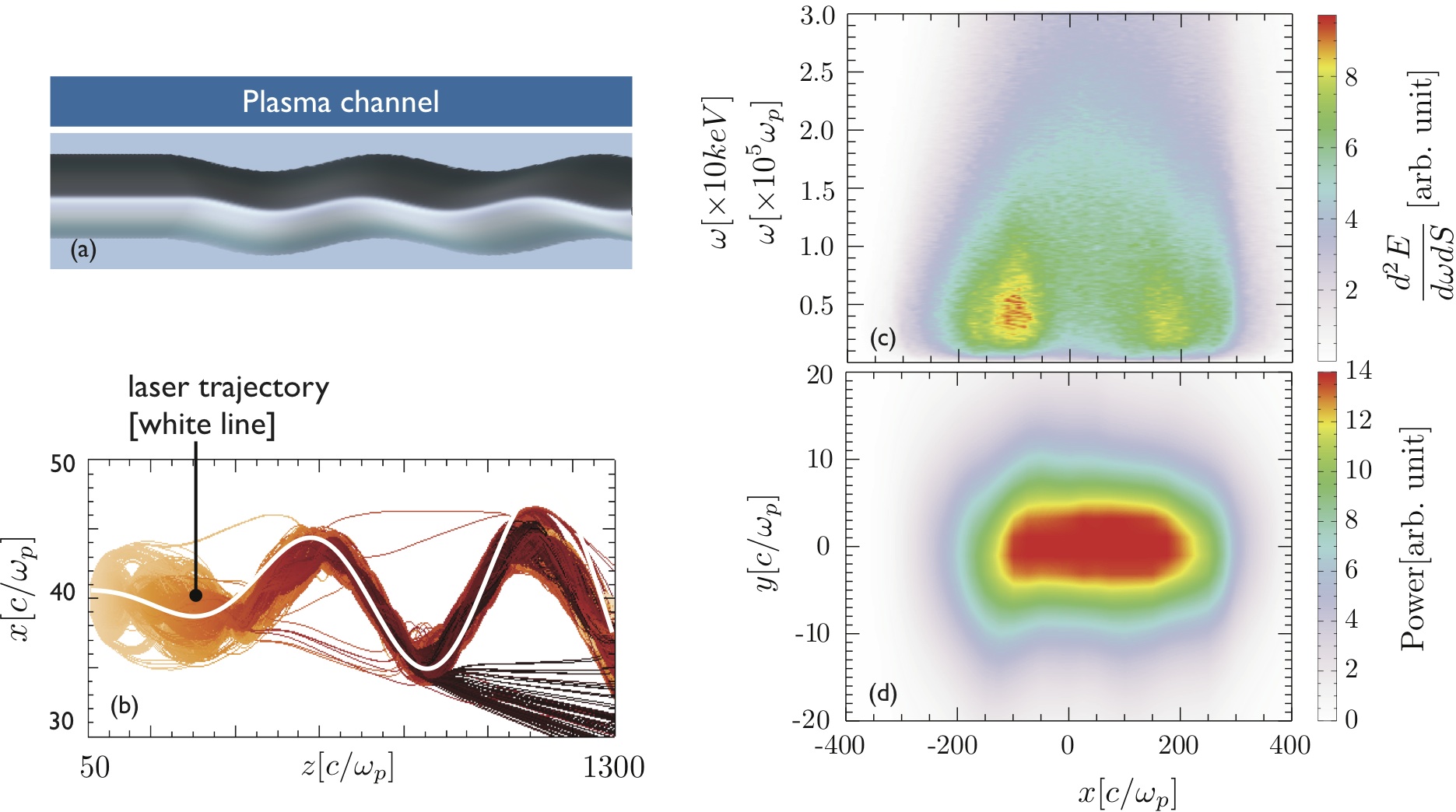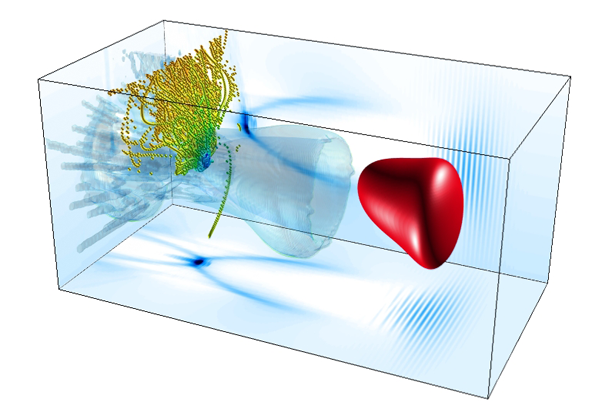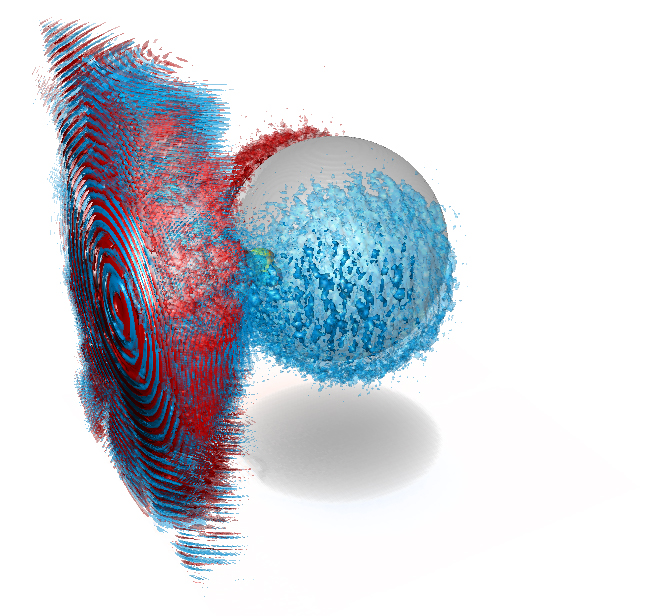-
Cascading in laser pulses
Read more
Among various quantum phenomena, electron-positron pair production, at the focus of an intense laser, is currently a topic of considerable interest. As is typical for particle scattering experiments, many different processes may contribute to the final yields of pairs. Out of the possible mechanisms, pair production seeded by an electron is likely to be the most dominant. This process comes in a two step process, in which non linear Compton scattering produces a real photon from the incoming electron and this real photon then goes on to create a pair via stimulated pair production (Breit-Wheeler).
The figure depicts the development of a QED cascade. The cascade is a direct consequence of the nonlinear Compton combined with the Breit-Wheeler process: successive events of hard photon emissions and electron-positron pair photo-production by hard photons. The cascade is here seeded initially by an electron trapped in the beating of two counter-propagating ultra-intense laser…
February 18, 2014 -
Propagation of ultra-relativistic fireball beam into static plasma
Read morePlasma instabilities are strong candidates for seed magnetic field generation and to explain radiation processes associated with Gamma Ray Bursters. Intense efforts have been devoted to explore possible mechanisms for the amplification of seed magnetic fields in plasmas. Since astrophysical measurements are currently limited, it is both interesting and important to investigate novel configurations to probing these mechanisms in the laboratory. It has been recently proposed that the interaction of relativistic fireball (electron+positron) bunches at Standford Linear Accelerator (SLAC) could be used in experiments to explain magnetic field amplification in astrophysical scenarios through the current filamentation instability. Fireball beam plasma interaction experiments are then crucial to understand the conditions enabling the growth of the relevant plasma instabilities, amplification of ambient magnetic fields, and shock formation in relativistic fireballs.
Ab initio plasma PIC simulations in astrophysical conditions have provided new directions to understand these questions, identifying the role of plasma instabilities…
January 30, 2014 -
Negative Cherenkov emission
Read more
A relativistic electron bunch (represented by the spheres in red scale) propagates in a negatively refracting metamaterial exciting Cherenkov radiation (represented by the magnetic field isosurfaces in blue).
The unusual characteristics of electromagnetic waves in negative index metamaterials, namely the antiparallel phase and group velocities, lead to the formation of reversed Cherenkov radiation cones that point away from the electron bunch.
January 27, 2014 -
Minimagnetosphere formation above lunar surface
Read moreThis image illustrates the collision of the solar wind plasma (flowing from top to bottom) with a localised crustal magnetic field structure (represented by the blue field lines). A symmetric magnetic field structure is present in the left hand side of the box, but has been omitted in this figure for sake of clarity. The red cloud represents the space-charge electric field at the magnetopause, which is set up by the different penetration between ions and electrons at the edge of the magnetosphere. The lateral-projections of the electric field structure reveal interesting kinetic features: the projection on the left shows a rippled surface structure, due to the diamagnetic electron-ion drift instability which occurs perpendicular to the magnetic field lines; in contrast, the projection on the right shows a smooth surface structure since the relative electron-ion drift is absent. The electric field cloud is responsible for shielding the lunar surface…
January 27, 2014 -
Channel through
Read more
A low-intensity laser can propagate through an underdense plasma weakly interacting with it. In other words, the plasma is transparent for the laser – the energy of the laser does not dissipate much into the medium. But, if the laser is very intense, it has a strong interaction even with underdense plasma. If we would like a strong laser to propagate in a stable manner through a long plasma slab without significant losses, a guiding structure is needed. This structure can be a plasma channel – a lower density tunnel with a specific density shape such that a laser is prevented from defocusing.
This is relevant for fast ignition, because the ignition laser should be transported to the core of the target, minimising the losses to the interaction with pre-plasma.
A long low-intensity laser directed through a plasma can “drill” this type of channel. The electrons are expelled sideways, and if the laser is long enough, the plasma ions…
January 20, 2014 -
Plasma acceleration revolution: Proton Driven Plasma Wakefield Accelerator
Read more
As conventional particle acceleration techniques are hitting technological limits, plasma based acceleration is emerging as a leading technology in future generations of higher energy, compact particle accelerators. Although initially proposed more than 30 years ago by J. M. Dawson at the University of California in Los Angeles (UCLA), the first ground breaking plasma acceleration experimental results only appeared recently in 2005. Plasma acceleration is presently an active field of research, being pursuit by several leading laboratories (e.g. SLAC, DESY, RAL, LOA, LBNL).
Electron or positron acceleration in plasma waves is similar to sea wave surfing. Plasma accelerators use an intense laser pulse or particle bunch (boats on water) as driver to excite relativistic plasma waves (sea waves for surfing). Accelerating structures are sustained by plasma electrons and are not affected by physical boundary effects as in conventional accelerators. The plasma accelerator only lasts for the driver transit time through the…
January 20, 2014 -
Self-injection in corrugated plasma channel
Read moreFig.1 (a) Corrugated plasma channel, (b) tracks of randomly selected trapped electrons (while line is the laser trajectory), (c) x-ray radiation spectrum, and (d) radiation spot profile in the transverse plane.
One of the potential applications of the accelerating and wiggling electrons in the blowout regime of laser wakefield acceleration is the generation of highly focused x-ray radiation in the direction of electron acceleration. The large accelerating fields associated with the blowout, which can trap and accelerate plasma electrons (self-injection), lead to the generation of quasi-mono-energetic multi-GeV electrons. In addition, the linear transverse focusing forces associated with the bubble triggers the wiggling of electrons which leads to the generation of x-ray radiation.
It has been already shown that laser frequency chirp and plasma density inhomogeneities provide a strong tool to control the transverse dynamics of laser and hence the dynamics of electron bunch in the…
January 15, 2014 -
Harnessing the electron bunch in the wake of the laser
Read moreFig.1 Snap shot of transversely chirped laser superimposed over the plasma electron density profile at various time to illustrate the off-axis injection of particles in the bubble. Plasma has a linear transverse density gradient.
The potential of the blowout regime for several applications has been confirmed in numerous experiments. The large accelerating fields associated with the blowout, which can trap and accelerate plasma electrons (self-injection), lead to the generation of quasi-mono-energetic multi-GeV electrons. In addition, the linear transverse focusing forces associated with the bubble are ideal for the generation of x-ray radiation, as the accelerated electron beams perform betatron oscillations in the ion channel. The beams obtained from LWFA also have potential to drive a free electron laser. For these applications it is crucial to control and manipulate the injection process that determines the charge, energy, energy spread and strength parameter for x-ray radiation. Although…
January 15, 2014 -
Intense lasers for shock acceleration of ions
Read moreIons are already successfully used for cancer treatment, but for that, big and costly facilities are necessary to accelerate them to energies up to 250 MeV per nucleon. Strong effort is done recently in developing a size and cost-reduced laser-based acceleration scheme that can be brought into practice.
The challenge now is to optimize the acceleration scheme to increase the ion energy while having a sufficient number of accelerated particles. The interchange between experiment and simulations is essential at this stage to find the best setting. 2D simulations overestimate the efficiency, thus it is necessary to perform 3D simulations in order to make quantitative statements.Fig. 1: The laser field shown in red/blue cannot penetrate the target and is reflected at the front surface. The expanding electrons create an additional TNSA field around the spherical target.
In the shock acceleration scheme, the plasma target is so dense that the laser cannot penetrate…
January 15, 2014
extreme plasma physics > Visualizations

